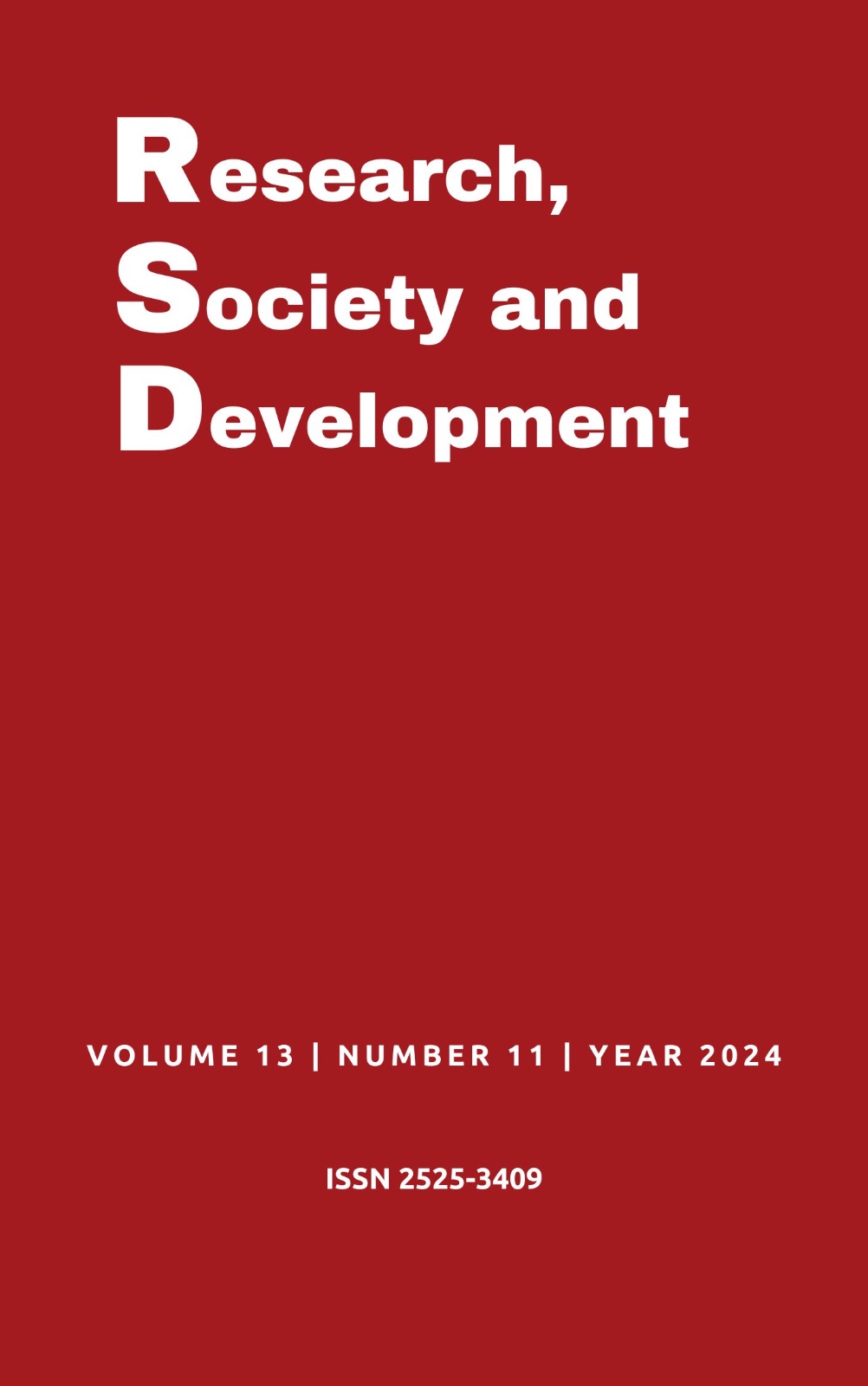Role of the nurse in the management of postpartum hemorrhages: A literature review
DOI:
https://doi.org/10.33448/rsd-v13i11.47116Keywords:
Postpartum hemorrhage, Postpartum period, Nursing care, Maternal mortality, Prevention.Abstract
Objective: To thoroughly analyze the role of nurses in managing postpartum hemorrhage, focusing on the skills necessary for the prevention, early detection, and treatment of this obstetric complication, which remains one of the leading causes of maternal morbidity and mortality worldwide. Materials and Methods: This is an integrative literature review covering studies published between 2019 and 2023 in the Scielo, Lilacs, and PubMed databases, using specific descriptors related to the topic. The analysis of the studies revealed that effective prevention of postpartum hemorrhage requires early identification of risk factors during prenatal care, a critical role performed by nurses, who must also provide detailed educational information to pregnant women. Results: The importance of continuous training and evidence-based protocol updates was emphasized to ensure intervention effectiveness and care safety. The results highlight the need for an interdisciplinary approach in postpartum care, underscoring the central role of nurses in coordinating care and providing psychosocial support. The research also identified the relevance of health policies promoting continuous training of nursing professionals and adherence to updated clinical protocols. Final considerations: In conclusion, this study contributes to raising awareness about the importance of evidence-based practices and health policies that strengthen obstetric nursing practices, offering guidelines to improve postpartum hemorrhage management and, consequently, reduce maternal mortality.
References
Andrade, J. L., & Lima, R. M. (2022). Hemorragia puerperal: Aspectos clínicos e intervenções de enfermagem. Revista Brasileira de Enfermagem, 75(2), e20210738. https://doi.org/10.1590/0034-7167-2021-0738
Bardin, L. (2016). Análise de conteúdo. São Paulo: Edições 70.
Begley, C., Gyte, G. M. L., Devane, D., & McDonald, S. (2019). Interventions for preventing postpartum hemorrhage. Cochrane Database of Systematic Reviews, 2019(12). https://doi.org/10.1002/14651858.CD001367.pub3
Brasil. (2023). Diretrizes para o manejo da hemorragia puerperal. Ministério da Saúde. http://www.saude.gov.br
Brown, H., & Davies, L. (2021). Preventing postpartum hemorrhage: The role of prenatal education. Journal of Obstetric, Gynecologic & Neonatal Nursing, 50(2), 123-131. https://doi.org/10.1016/j.jogn.2021.01.002
Brown, H., Jones, A., & Smith, K. (2021). Clinical management of postpartum hemorrhage. American Journal of Obstetrics & Gynecology, 224(4), 381-388. https://doi.org/10.1016/j.ajog.2020.10.014
Cavalcante, L. T. C., & Oliveira, A. A. S. (2020). Métodos de revisão bibliográfica nos estudos científicos. Psicologia: Teoria e Pesquisa, 26(1), 82-100. https://doi.org/10.5752/P.1678-9563.2020v26n1p82-100
Costa, L. S., & Almeida, M. L. (2020). Humanização do parto e nascimento: Impactos na saúde materna. Revista Brasileira de Saúde Materno Infantil, 20(3), 475-485. https://doi.org/10.1590/1806-93042020000300011
Coutinho, J. R., & Ferreira, M. R. (2021). Efeitos da humanização do parto na saúde da mãe e do recém-nascido. Cadernos de Saúde Pública, 37(5), e00067820. https://doi.org/10.1590/0102-311X00067820
Ferreira, J. C., Sousa, R., & Pereira, C. (2021). Protocólos baseados em evidências para a gestão da hemorragia puerperal. Enfermería Clínica, 31(1), 45-51. https://doi.org/10.1016/j.enfcli.2020.10.012
Fiocruz. (2019). Mortalidade materna no Brasil: Análise e propostas para redução. Fundação Oswaldo Cruz. http://www.fiocruz.br
Jones, L., & Clark, H. (2020). The role of the multidisciplinary team in managing postpartum hemorrhage. Journal of Perinatal Medicine, 48(7), 746-754. https://doi.org/10.1515/jpm-2019-0210
Marinho, A. S., & Pereira, D. D. (2023). A importância da educação em saúde na prevenção da hemorragia puerperal: Um estudo de caso. Enfermeagem em Foco, 14(1), 56-63. https://doi.org/10.21675/2357-707X.2023.v14.n1.3642
Mendes, K. D. S., Silveira, R. C., & Galvão, T. F. (2008). Revisão integrativa: Método de pesquisa para a prática de enfermagem. Revista Brasileira de Enfermagem, 61(2), 258-263. https://doi.org/10.1590/S0034-71672008000200015
Oliveira, J., Rodrigues, R., & Lima, A. (2023). O papel do enfermeiro no manejo das hemorragias puerperais: Uma revisão crítica. Revista de Enfermagem Referência, 6(2), 55-64. https://doi.org/10.12707/RIV21046
Rother, E. T. (2007). Revisão sistemática x revisão narrativa. Acta Paulista de Enfermagem, 20(2). https://doi.org/10.1590/S0103-21002007000200001
Silva, D. A., & Santos, E. M. (2022). Intervenções de enfermagem para a prevenção da hemorragia puerperal. Enfermagem em Foco, 13(1), 77-84. https://doi.org/10.21675/2357-707X.2022.v13.n1.3615
Silveira, G. M., & Pimentel, G. S. (2020). Protocólos de atendimento para prevenção de hemorragias no puerpério: Revisão sistemática. Revista Latino-Americana de Enfermagem, 28, e3327. https://doi.org/10.1590/1518-8345.4399.3327
Smith, T., Davis, J., & Williams, R. (2022). O impacto da formação contínua na prática de enfermagem obstétrica. Nursing & Health Sciences, 24(2), 213-220. https://doi.org/10.1111/nhs.12887
White, R., & Johnson, J. (2023). Coordenação multidisciplinar no manejo da hemorragia puerperal. International Journal of Obstetric Anesthesia, 42, 15-22. https://doi.org/10.1016/j.ijoa.2023.04.003
World Health Organization [WHO]. (2019). Strategies to reduce maternal mortality. World Health Organization. https://www.who.int/publications/i/item/9789241504184
Downloads
Published
Issue
Section
License
Copyright (c) 2024 Ana Clara Letícia Pinheiro da Silva de Jesus; André Santos Freitas; Luana Araújo dos Reis

This work is licensed under a Creative Commons Attribution 4.0 International License.
Authors who publish with this journal agree to the following terms:
1) Authors retain copyright and grant the journal right of first publication with the work simultaneously licensed under a Creative Commons Attribution License that allows others to share the work with an acknowledgement of the work's authorship and initial publication in this journal.
2) Authors are able to enter into separate, additional contractual arrangements for the non-exclusive distribution of the journal's published version of the work (e.g., post it to an institutional repository or publish it in a book), with an acknowledgement of its initial publication in this journal.
3) Authors are permitted and encouraged to post their work online (e.g., in institutional repositories or on their website) prior to and during the submission process, as it can lead to productive exchanges, as well as earlier and greater citation of published work.


